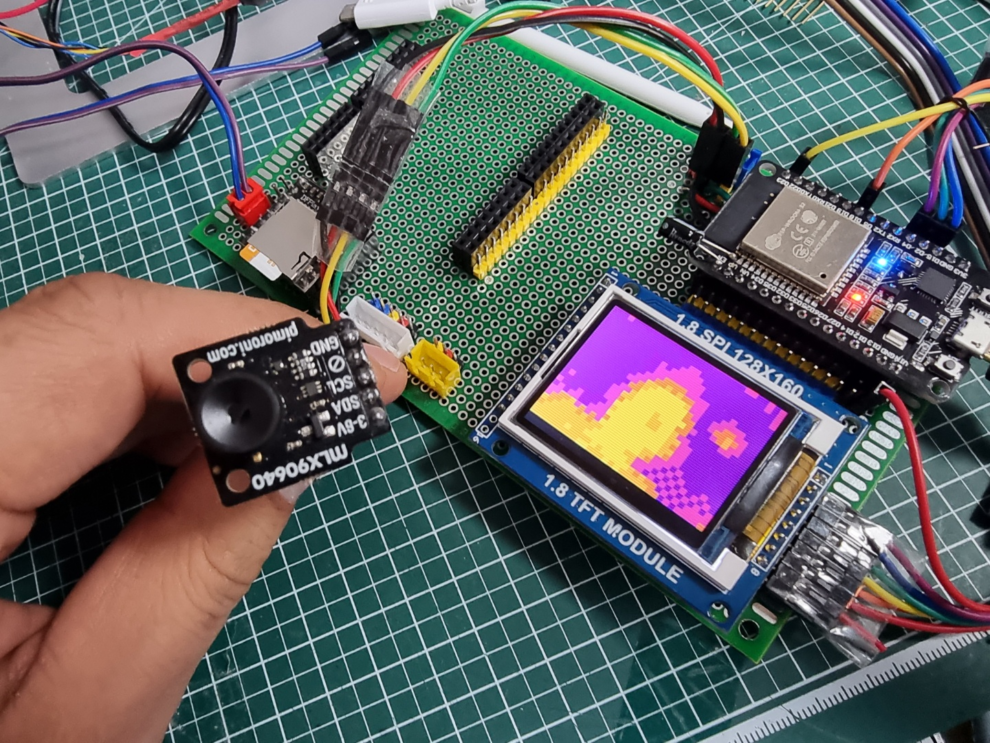Thermal sensors, such as the MLX90640, are used to detect and measure temperature differences. These sensors are commonly used in various applications, such as medical devices, automotive, and home automation systems. Annotating these sensors involves adding additional information to the sensor readings, which can help to make the data more meaningful and useful.
To annotate the thermal sensor MLX90640, it is important to understand the basics of how the sensor works. The MLX90640 uses infrared technology to measure temperature differences in a specific area. This sensor consists of an array of 32×24 pixels, and each pixel provides a temperature reading.
Annotating the sensor involves recording additional information such as the location of the sensor, the time of the reading, and any other relevant data. This information can then be used to create more accurate temperature maps, detect temperature changes over time, and provide more insights into the data captured by the sensor.
Table of Contents
How To Annotate Thermal Sensor MLX90640
Here are the details about how to annotate thermal sensor MLX90640:
Understanding the MLX90640 sensor
The MLX90640 is a thermal sensor that uses infrared technology to detect and measure temperature differences. It consists of an array of 32×24 pixels, and each pixel provides a temperature reading. This sensor can detect temperatures from -40°C to 300°C and has a high accuracy of ±1°C. The MLX90640 can be used in various applications, including medical devices, automotive, and home automation systems.
It provides a non-contact method of measuring temperature and is ideal for situations where direct contact may not be possible or desirable. Understanding the MLX90640 sensor and its capabilities is important when annotating the sensor readings.
Basics of annotating the MLX90640 sensor
Annotating the MLX90640 sensor involves adding additional information to the temperature readings. This information can help to make the data more meaningful and useful. The basics of annotating the MLX90640 sensor include recording the location of the sensor, the time of the reading, and any other relevant data.
The location of the sensor is important because it can affect the temperature readings. For example, a sensor located near a heat source will give different temperature readings than a sensor located in a cooler area. Therefore, it is important to record the location of the sensor to help interpret the data accurately.
The time of the reading is also important to record because it can help to detect temperature changes over time. For example, if a sensor takes a temperature reading every minute, the data can be used to track temperature changes over time. This can be useful for detecting patterns, trends, or anomalies in temperature data.
Finally, any other relevant data should be recorded to help provide context for the temperature readings. This could include information about the environment, the purpose of the sensor, or any other factors that may affect the data. By recording this additional information, the data becomes more useful and can be used to make informed decisions.
Record the location of the sensor
Recording the location of the MLX90640 sensor is an important step in annotating it. This information can help to identify temperature changes in different areas and provide context to the captured data. To record the location, it is important to identify the exact position of the sensor, including the room or space it is located in. It can be helpful to include the coordinates of the sensor’s position as well, especially if it is in a larger area or building.
In some cases, it may also be important to record the orientation of the sensor. For example, if the sensor is mounted on a wall or ceiling, it may be facing a particular direction. Recording this information can help to identify temperature changes that are specific to that direction.
Overall, recording the location of the MLX90640 sensor is a key step in annotating it, and can help to provide more insights into the captured data.
Record the time of the reading
Recording the time of the reading is an essential part of annotating the MLX90640 sensor. The timestamp provides information on when the temperature reading was taken and can be used to track changes over time. This information is particularly useful for applications where temperature changes can occur rapidly, such as in industrial settings or medical devices.
To record the time of the reading, the annotation should include the date and time that the temperature reading was taken. This can be done using a timestamp or by simply noting the time and date in the annotation. It is important to ensure that the time zone is consistent and accurately recorded, especially if the sensor is being used in multiple locations. By including the time of the reading in the annotation, it is possible to track temperature changes over time and identify any patterns or anomalies that may occur.
Record any other relevant data
Apart from the location and time of the reading, there are other relevant data that can be recorded while annotating the MLX90640 sensor. Some of these include:
- Environmental conditions – The temperature readings can be affected by environmental conditions such as humidity, wind, and altitude. Recording these conditions can help to make the data more accurate and reliable.
- Object/material being measured – The type of object or material being measured can also affect the temperature readings. For instance, a metal object will have a different temperature reading compared to a plastic object. Annotating the material being measured can help to provide more context to the data.
- Distance from the object – The distance between the sensor and the object being measured can also affect the temperature readings. Annotating the distance can help to ensure that the data captured is accurate and reliable.
- Sensor calibration – It is important to calibrate the sensor regularly to ensure that it is functioning correctly. Annotating the calibration data can help to track when the sensor was last calibrated and if any adjustments were made.
Benefits of annotating the MLX90640 sensor
Annotating the MLX90640 sensor can bring numerous benefits, such as creating accurate temperature maps, detecting temperature changes over time, and providing more insights into the captured data. Annotated data can be used to improve system performance and reduce errors.
By recording the location of the sensor, it is possible to create more accurate temperature maps, which can be used for environmental monitoring, object detection, and other applications. With the addition of time-stamp data, it becomes possible to detect temperature changes over time and track trends in the data.
Annotating the MLX90640 sensor also provides more insights into the captured data. By recording any other relevant data, such as the surrounding conditions and other sensor data, it is possible to analyze the data in greater detail. The additional information can also help identify patterns, trends, and anomalies that may be missed otherwise. Overall, annotating the MLX90640 sensor can help to extract more value from the captured data, providing more insights and improving the accuracy and performance of the system.
Creating accurate temperature maps
One of the main benefits of annotating the MLX90640 sensor is the ability to create more accurate temperature maps. By adding additional information to the sensor readings, it is possible to create a visual representation of the temperature differences in a specific area. These temperature maps can be used in various applications, such as in building inspections or home energy audits, to identify areas where temperature differences are occurring.
To create accurate temperature maps, it is important to record the location of the sensor as well as the time of the reading. This information can then be used to create a spatial and temporal record of the temperature differences in the area. By recording the location of the sensor and the time of the reading, it is possible to identify areas where temperature differences are occurring and to track changes over time.
Accurate temperature maps can be used to identify areas where energy efficiency improvements can be made. For example, in a home energy audit, a temperature map can be used to identify areas where insulation is lacking, or where there is air leakage. By identifying these areas, it is possible to make improvements that can lead to energy savings and more comfortable living spaces.
Detecting temperature changes over time
Annotating the MLX90640 sensor can help in detecting temperature changes over time. By recording the time of each temperature reading, it is possible to identify changes that occur over time. This information can be used to monitor temperature trends and identify any patterns that may be present.
For example, in medical devices, annotating temperature readings over time can help in detecting a fever that may be developing, or in automotive applications, annotating the temperature of the engine over time can help in identifying any potential issues with the vehicle. This can help in taking preventive measures before any serious problems arise. Overall, annotating the MLX90640 sensor helps in monitoring temperature changes over time, which can be valuable in a wide range of applications.
Providing more insights into the captured data
Annotating the thermal sensor MLX90640 can provide more insights into the captured data. With the additional information, it is possible to analyze the temperature readings with more accuracy and context. For instance, if the sensor is used in a room, annotating the sensor data can help to identify the temperature distribution across the room, which can inform decisions on the placement of heating and cooling systems.
Annotated data can also help to detect temperature changes over time. This can be useful in monitoring the performance of devices, such as motors and other equipment that generate heat. By comparing temperature readings over time, it is possible to identify anomalies that could indicate potential issues.
In summary, annotating the thermal sensor MLX90640 can help to provide more insights into the captured data, which can inform decision-making, detect potential issues, and optimize the performance of equipment and systems.
In conclusion
Annotating the thermal sensor MLX90640 can provide additional information that can help to make the data more meaningful and useful. By recording the location of the sensor, the time of the reading, and any other relevant data, it is possible to create more accurate temperature maps, detect temperature changes over time, and provide more insights into the data captured by the sensor.
This information can inform decision-making, detect potential issues, and optimize the performance of equipment and systems. Overall, annotating the thermal sensor MLX90640 can help to enhance the value and utility of temperature data.




Add Comment